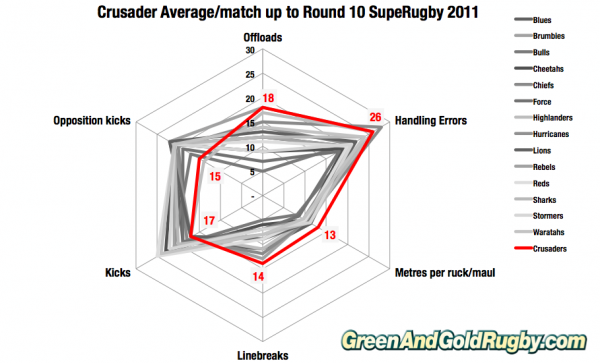They’ve been slowed a little lately by a host of injuries, but the Crusaders are surely once again the team all Super Rugby coaches, players and supporters have sleepless nights over. Add that the perennial championship contenders constitute, both in terms of personnel and playing style, the core of the All Black squad for the upcoming World Cup, and you have a mouth-watering strategic question for anyone interested in rugby to ponder: how do you beat them?

The Crusaders of 2011 have been so impressive that I’ve dived into the stats to see if I can flag a few areas of either weakness or dependence to target. I’ll state the obvious at the outset: even if you can spot such opportunities, taking advantage of them isn’t going to be easy — plenty of teams with a hell of a lot more rugby nous than me have already tried and failed!
What strikes me as being most impressive about the Crusaders this year is their attack. So far they’ve scored 31 tries, which makes them the only team to be averaging close to four tries per match. Their mantra is to run, run, run, and they average 1,032 metres per game, which is second only to the Brumbies (by seven metres).
What sets them well apart from the Brumbies, and any other team, is the efficiency with which they make those metres: they take over 20 per cent fewer rucks and mauls per game to do it. This makes them the most efficient and effective running team in the competition, as they gain more than 13 metres per ruck/maul. The closest to them is the Stormers at just over 11. (The best Australian team is the Reds, at just over 10.)
How do the Cru achieve this? They have the highest average number of line-breaks (14) and offloads (18) per match (their high number of handling errors — 26 per game — reflects their willingness to try things on and push the pass). These and other skills result in opposition teams delivering the lowest tackle completion rate against them, at 87 per cent. (The Blues match the Crusaders on this score.)
How do you counter this? Strong, dominant defending is always a good idea, and is even more critical to counter the offload. It’s never gonna be easy against the Crusaders, as they have three of the top 10 offloaders in Dagg (13), Carter (13) and the best of them all, Sonny Bill Williams (31, at almost twice the next best, Luke Burgess on 17). SBW is also third in the comp on line-break assists — and he didn’t start in the only two games the Crusaders have lost. The output is clear: if there’s one man to shut down in the ‘Saders backline it’s Sonny Bill. Not that this will end all your headaches!
Probably more effective is to choke the Crusader mojo at its source. As I mentioned, the Cru love to run — outside their 22 they’ll always run, and will go through some 21 patterns of play before kicking. And they have the lowest number of kicks in the whole competition. It’s interesting that they also have the second-lowest number of kicks to them in the comp (only the Highlanders have fewer). This will be partly because they don’t engage in aerial ping pong, and because teams are wary of the counter-attack; 18 of the Crusaders’ 31 tries have come from kick returns and turnovers.
However, in a very Kiwi way, the Crusaders also have a glaring Achilles’ heel: their line-out. Their attacking line-out currently languishes at the very bottom of the Super ladder. So the mandate becomes clear: kick for touch and structure the game.
A nice bit of Kryptonite to add into this mix is slow ball — the Crusaders hate it. They have the lowest rate of slow attacking ball in the competition, at 12 per cent; however, in the two games they’ve lost this season, that number has been over 20. Competing at the breakdown is therefore vital, and the key to that is dominant defence to get over and past their ball carriers.
Spotting the opportunities is one thing; executing against such a quality side is a whole different ball game. So another question arises: who can tame the full-strength Crusaders? And that’s what the rest of the 2011 Super Rugby comp is all about.

